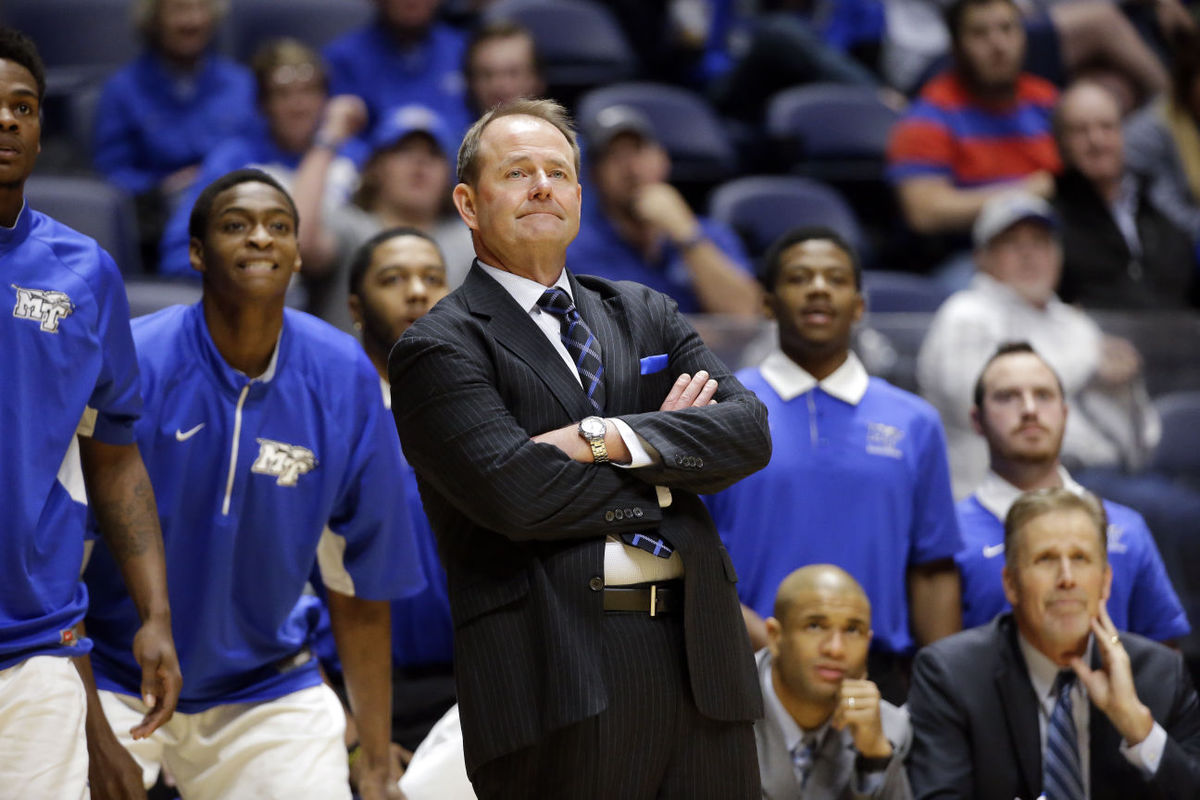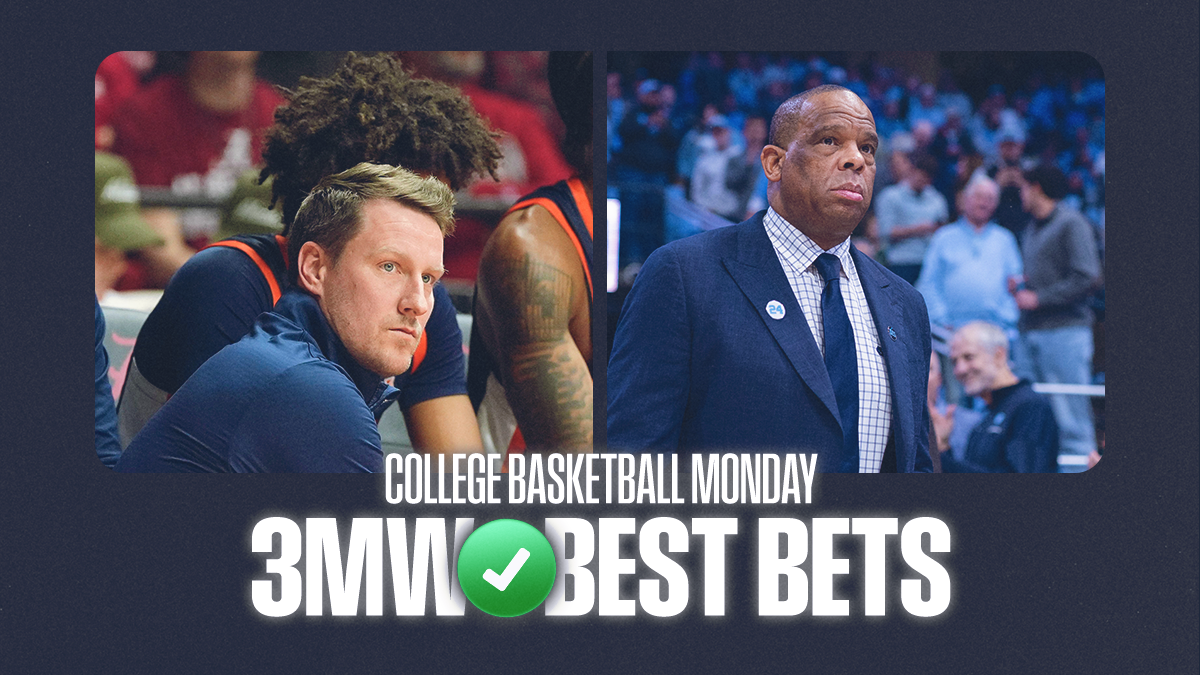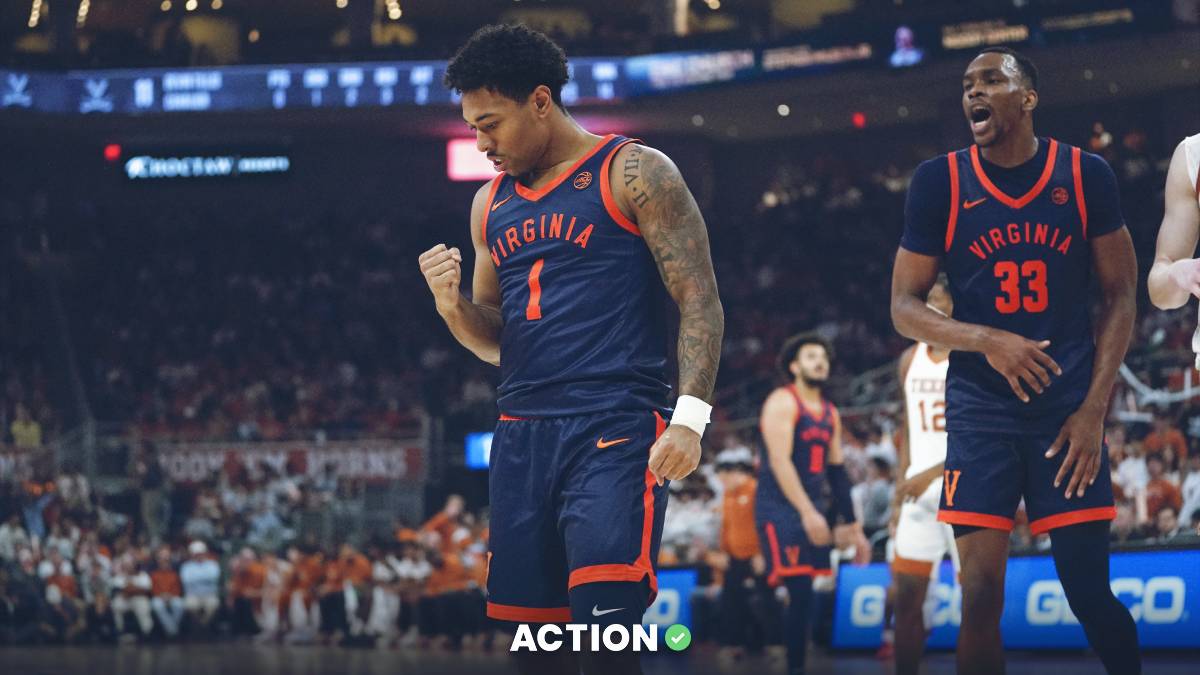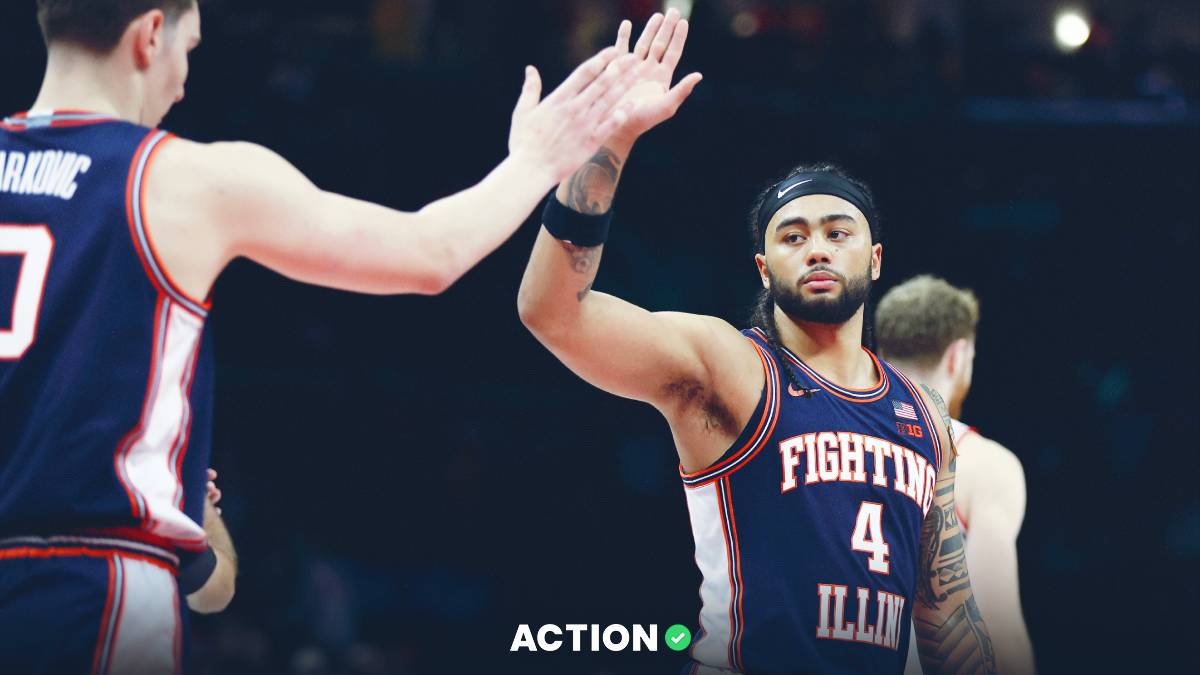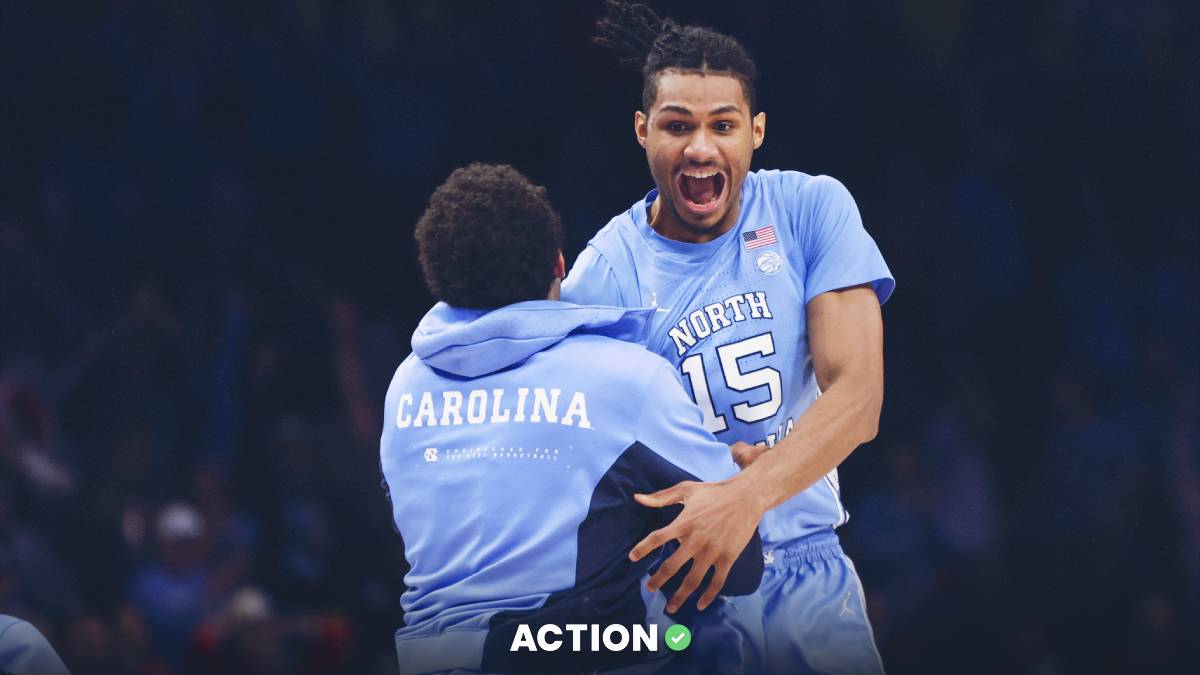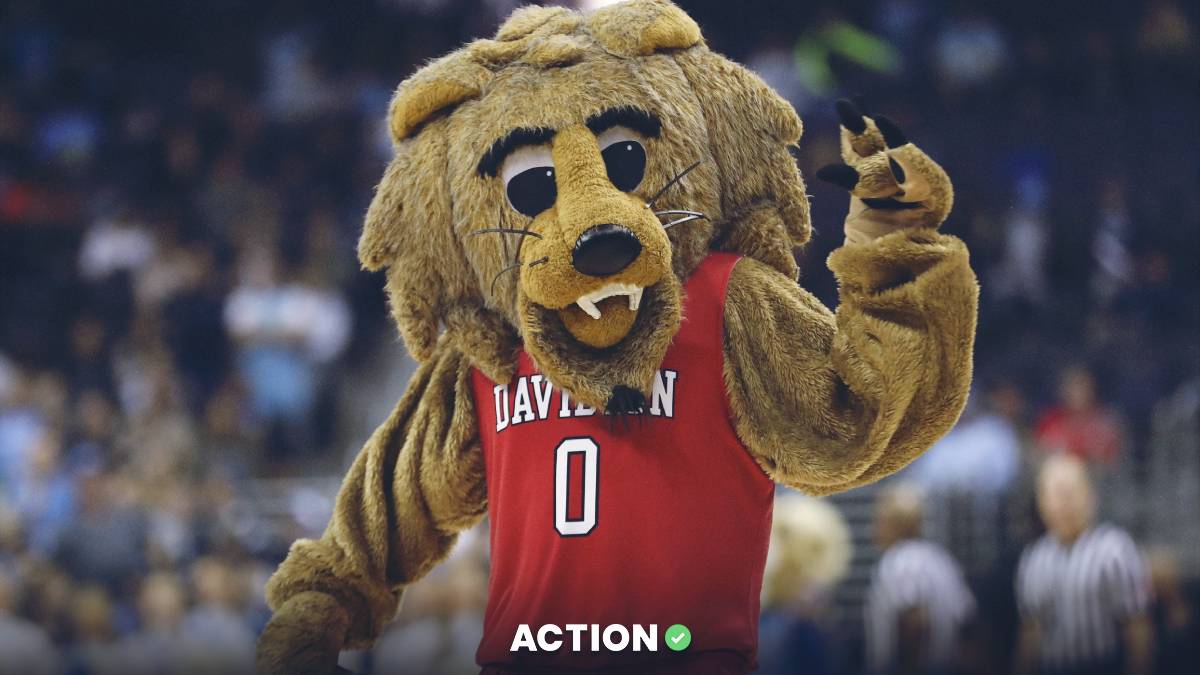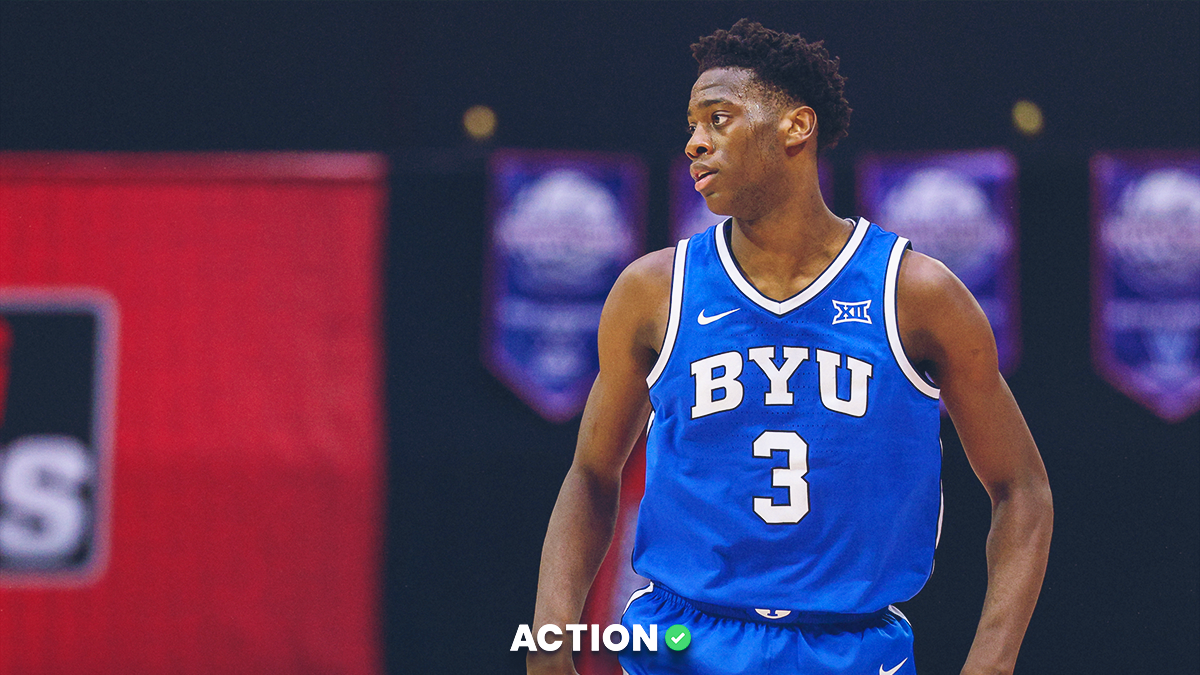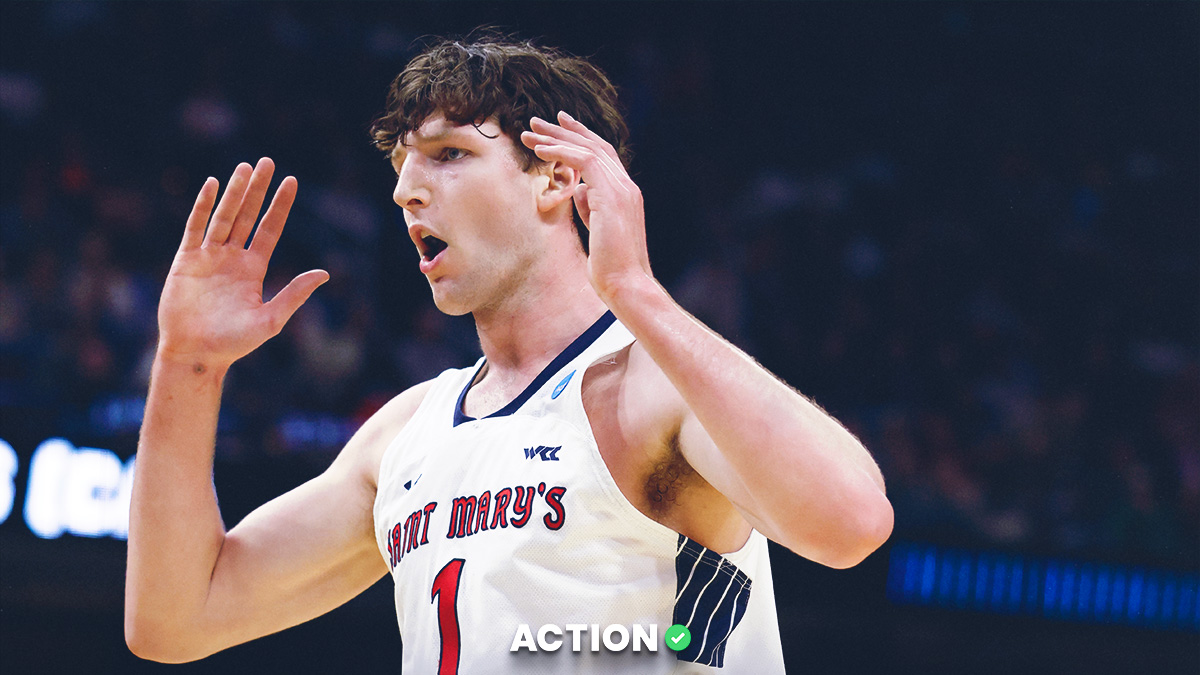1. The upper crust of the league (Middle Tennessee, UAB, Louisiana Tech and Old Dominion) looks to be hyper competitive this year. Can two teams separate to form an elite tier and perhaps get the league multiple NCAA Tournament bids? Or will they just beat each other up and leave the league stuck at one bid for the sixth straight season?
2. Who is playing for Western Kentucky? Tapha Diagne and most importantly Josh Anderson are still waiting on clearance from the NCAA. Until then, it's almost impossible to rank the Hilltoppers.
3. Scott Pera at Rice and Grant McCasland at North Texas are the league's two new coaches, but the seats at the two Florida schools could be getting pretty toasty.
PREDICTED ORDER OF FINISH:
1. Middle Tennessee– Kermit Davis has built a dynasty in Murfreesboro, and at this point, a third straight NCAA Tournament win wouldn't shock anyone. MTSU dominated the CUSA last year, losing only once in league play. This year Davis has a bit of work to do, as he has to replace the dynamic frontcourt duo of Reggie Upshaw and JaCorey Williams. Upshaw's leadership and presence on and off the court aren't really replaceable, but Alabama transfer Nick King has a very similar hybrid skill set to Williams. King is a three-level scorer, and he'll play alongside what could be one of the best 5s in the league in Brandon Walters. Walters is a true post who can be used in pick and pop. Neither Williams nor Upshaw was necessarily a consistent back-to-the-basket scorer, so the Blue Raider offense will have a new wrinkle. If Walters continues to develop at the rate his end of season play last year suggests, MTSU's frontcourt will be just fine. Walters' per minute offensive rebounding rate is absurdly high, and he's a skilled rim protector as well. King is also an outstanding two-way rebounder because of his athleticism, and Kermit Davis teams always rebound at an elite national level. Where I worry with the new frontcourt is on the defensive end, as Upshaw and Williams' versatility was key in Davis' zone defense. I've gone on at length about Davis' shape shifting zone, but even teams who have seen it before have a hard time picking up the back and forth switching between a 2-3 and an aggressive 1-3-1 that could use both Williams and Upshaw trapping on the perimeter. It might take a while for King to catch up in live game action, and I'm now sure how effective Walters will be, but the rebounding should still be elite. 6–foot-9 Davion Thomas is a former three-star recruit who Davis has described as the best athlete he's coached. He'll provide valuable frontcourt depth, and JUCO James Hawthorne has defensive glue guy written all over him. Freshman TJ Massenburg is a typical Davis big man recruit, as he can play 3/4/5 and face the basket, while veteran Karl Gamble has posted excellent rebounding and block rates in limited minutes. The backcourt is going to carry the team while King/Walters get settled in, as Tyrik Dixon and Giddy Potts are the best guard tandem in the league. Potts is an exceptional shooter who saw his numbers dip last year after an unsustainable freshman year, but he's still as pure of a shooter as there is in the country. He's a solid finisher at the rim with his bowling ball frame and is a valuable rebounding guard as well. Potts can handle point guard duties, but the sophomore Dixon really came into his own as the season progressed and should enter his second year as one of the most steady on-ball influences in the league. He posted the league's best 3-point percentage at a blistering 51 percent, as he made teams pay for overplaying on Potts. He also developed into an aggressive on-ball defender, posting CUSA's sixth-highest steal rate. Senior Ed Simpson is an underrated asset in the backcourt, as he's Davis' most technically sound perimeter defender and can knock down an open jump shot as the offense's fifth option. Antwain Johnson reprises his role as the an athletic slasher and menace at the top of the shifting zone. Upshaw and Williams were invaluable last year, particularly the former, but write the Blue Raiders off at your own peril.
- UAB- Considering the expectations and talent level of the Blazers last year, Robert Ehsan's first season had to be considered a significant disappointment. Things were derailed quickly when point guard Nick Norton blew out his knee in the first game of the year, and his absence likely took a toll on the development of HaHa Lee and Chris Cokley (although both were mostly phenomenal last year), as defenses were quick to collapse on them in the paint. Without Norton, the Blazers posted the league's second-highest turnover rate and lacked a consistent perimeter shooter outside of Denzel Watts. If Norton is healthy, the Blazers are a championship caliber team, as he posted the league's fourth-highest assist rate and highest steal rate, and he shot 41 percent from 3-point range two years ago and was one of CUSA's best penetrators. Even without Norton last year, Lee had a monster season and should be considered the frontrunner for conference player of the year honors. Along with .596/.388/.779 shooting slash line in league play, Lee dominated the defensive glass and blocked shots at the second-highest rate in the CUSA, earning him his second consecutive DPOY honor. Cokley returns at the 5 as a monster on the offensive glass and an efficient power post. A Lee/Cokley frontcourt combo is almost enough to catapult the Blazers back to the top of the league. Lew Sullivan and 7-footer Thomas Smallwood provide veteran depth in the frontcourt, while freshman Makhtar Gueye is a versatile 6-foot-10 stretch 4/5. The backcourt around Norton is equally solid, with Deion Lavender being allowed to shift back into a more natural 2/3, and Nate Darling could make a big leap as a sophomore after showing off a steady jump shot last year. JUCO Jalen Perry should bolster the subpar perimeter shooting, while two freshmen combo guards could log serious minutes spelling Norton or even playing beside him. Luis Hurtado is a big 6-foot-6 ball handler that can play 1-3, while Zach Bryant is the point guard of the future. With Norton back and intriguing lineup versatility, Ehsan should have a much smoother second season in Birmingham… assuming everyone stays healthy.
3. Louisiana Tech– Eric Konkol has the most talent and athleticism 1-5, and that could very well make the Dunkin' Dawgs the team to beat in a top-heavy CUSA. Konkol has to replace the unique do-everything skill set of Erik McCree, but the good news for LA Tech fans is that he has the firepower to do so, and the league's already third-best defense from year ago will probably improve upon their 0.95 points per possession without him. As good as McCree was offensively and on the glass, he was a bit of a liability defensively. Let's start with player of the year contender Jacobi Boykins, who posted a .561/.429/.813 slash line as a 6-foot-6 wing, and with his length and athleticism, he was the catalyst of a defense that logged the league's highest turnover rate and steal rate. Boykins is an NBA-level talent with his athleticism and versatile skill set on both ends. The backcourt around Boykins is absolutely loaded with athletic combo guards. Leading the charge is sophomore DaQuan Bracey, who was simply outstanding as a freshman PG, posting the league's highest assist rate and displaying a plus jump shot to keep defenses honest against his lethal penetration ability. Fellow sophomore Jalen Harris will be relied upon to replace some of McCree's production, while Derric Jean is yet another capable ball handler and defender. Jy'lan Washington returns on the wing and is probably the closest player Konkol has to McCree, and while he's not close to putting up the same numbers, he can play 2-4 competently, and he's a plus defender. Joniah White at the 5 is the only set "position" besides Bracey at the point. White has a solid post skill set and posted the league's highest block rate and offensive rebounding rate. Oliver Powell and highly-touted JUCO import Harrison Curry are options at the 4 and to spell White at the 5. LA Tech has no apparent flaws outside of some defensive rebounding issues, especially with McCree gone. The Dawgs can shoot from the perimeter, they wreak havoc defensively, and they were the 14th-most efficient transition offense in the country last year. It's fair to consider MTSU/UAB/LA Tech tri-favorites as the CUSA season begins.
4. Old Dominion– Jeff Jones teaches an outdated and archaic form of basketball…but he teaches it extremely well. The Monarchs under Jones have largely eschewed the "small ball" revolution and the floor spacing, up-tempo shockwaves of the NBA, as ODU doesn't annually shoots the three at one of the lowest rates in the country, but they dominate the glass on both ends and completely own the paint defensively. This year should be no different defensively, with Brandan Stith healthy and Trey Porter set to make a huge leap in the frontcourt, but the offense should have significantly more firepower, making the Monarchs a legit title contender. Stith is reportedly over the nagging injuries from last year and is in great shape physically. He's also developed a mid-range game, which should help because he wasn't very efficient in the post. Stith posted the league's third-highest block rate and fifth-highest offensive rebounding rate last year, and with Trey Porter slotted to see heavy minutes alongside him this year, it's tough to see anyone scoring at the rim consistently against the Monarchs. Porter's per minute rates as a shot blocker and rebounder are insane, and he's reportedly developed an offensive game away from the paint. If that pans out on the court this year, it will certainly add a new wrinkle to the usually torpid ODU offense. Porter is battling a minor knee hyperextension to start the year but should be fine long term. Jones has already lost some frontcourt depth with Alassane Kah and Greg McClinton lost for the year, leaving late Greek arrival Alf Pilavios as the only frontcourt member behind Stith, Porter and sophomore Aaron Carver. Pilavios is more of a stretch 3/4 hybrid, so he'll likely be playing out of position as a freshman. The backcourt of Ahmad Caver and and BJ Stith will be bolstered by freshman Michael Hueitt and a revamped wing corps that can brings a lot more athleticism and open floor ability in Marquis Godwin and Xavier Green. Caver is an ODU player through and through, rarely leaving the floor at point and posting the league's fourth-highest assist rate and 10th-highest steal rate; plus, he was the only Monarch to shoot the 3 consistently, at 40 percent in league play. Hueitt can slot in off the ball immediately, and he'll probably be Jones' best scoring option on the perimeter. Jones has said he wants to increase the tempo with athletic wings Godwin and Green coming as freshman (Green of the redshirt variety). Jones' teams have rarely played north of 60 possessions, so I'll believe it when I see it, but if the ODU offense is a top five unit from an efficiency standpoint this year, they'll certainly be in contention for the league title, if not the favorite.
5. Western Kentucky– The Hilltoppers are the hardest team to rank in the CUSA, and that's not because of Mitchell Robinson, whose saga I'm not going to rehash. The main issue is that I have no idea who is on the team as I type this. Rick Stansbury has lured high-major talent to Bowling Green, but will any of them actually see the court? There was the whole Robinson soap opera over the summer, but now highly touted wing Josh Anderson and big man Tapha Diagne have yet to be cleared by the NCAA. If those two highly talented players aren't cleared, Stansbury essentially has a seven-man rotation. Stansbury has also been working in an entirely new coaching staff, one of which was just dismissed after a DUI. Let's assume Anderson and Diagne don't get cleared. It's a big blow, but Stansbury still has an exceptionally solid starting 5, led by Justin Johnson, who has become a versatile offensive threat by adding a jump shot to his interior game. He's also one of the best rebounders in the league on both ends. He'll be joined in the frontcourt by Ole Miss/Kansas transfer Dwight Coleby, who shores up two major weaknesses for WKU – team rebounding and rim protection. The starting backcourt will feature two more transfers, dual ball handlers Lamonte Bearden out of Buffalo and Darius Thompson out of Virginia. Bearden is a ferocious on-ball defender and can orchestrate a lethal transition offense, while Thompson learned the methodical motion offense of Tony Bennett at UVA. With the potential lack of depth, look for Stansbury to lean more toward keeping the possessions low with Thompson as the primary ball handler (WKU played around 66 possessions last year), but Bearden will be a key cog as well, especially defensively. Josh Anderson was expected to be the centerpiece offensively on the wing, but if he's ineligible, that duty will fall to Taveion Hollingsworth, a high-scoring wing out of Lexington and Kentucky's Mr. Basketball, and Jake Ohmer, a sharpshooting freshman. The loss of Anderson would be enormous, and the loss of Diagne would hurt a woeful interior defense, so consider WKU's ranking TBD.
6. UTEP– After home losses to Southeastern Louisiana, Northwestern State, UMES and Northern Arizona were followed by three straight league losses (including at USM), I was calling for the head of Tim Floyd. Then two things happened: 1) Floyd, the master of junk zones, finally devised a junk zone that actually worked. It's hard to describe, but it was like a matchup zone/pack line that completely eliminated dribble penetration and forced offenses to beat them over the top with jump shots. That defense led UTEP to the second-best efficiency rating in the league, and while it allowed a ton of 3-pointers, teams shot just 30 percent against the bewildering hybrid zone. 2) 7-foot-1 center Matt Willms' foot healed, and the Miners went 12-3 from there on out. Willms was granted a sixth year of eligibility and gives Floyd one of the best low post presences in the league. Paul Thomas returns at the 4 to give Floyd a formidable dual post lineup that can rebound well out of the zone. The sudden departure of 6-foot-11 Kelvin Jones was a huge hit to the UTEP frontcourt, leaving depth up to freshman Tirus Smith, who has been impressive in practice/scrimmages. Jake Flaggert returns to his efficient spot shooting role at the 3, but the backcourt has to be reshuffled a bit in the absence of Dominic Artis. Off guard Omega Harris could run the point, but it would probably worsen an already questionable offensive output from an efficiency standpoint. The best bets are two freshmen, Chicago prep Evan Gilyard and Kobe Magee. Gilyard is more of a distributor, while Magee is a high-scoring combo guard. Off the ball, redshirt freshman Trey Wade and Canadian JUCO product Isiah Osborne should provide the bulk of the scoring alongside Harris. The wildcard in the backcourt is well traveled but ultra talented Keith Frazier. He didn't provide much in a stop in Denton last year, but if healthy and focused, he could be a game changer for Floyd. Point guard issues on a team that was 10th in efficiency rating last year is troubling, and coaches will be more prepared for Floyd's wacky zone this year, which limits the upside of the Miners, but a top-half finish should be expected.
7. Charlotte– Mark Price's backcourt last year? Stellar. Mark Price's frontcourt last year? Nonexistent. No team in the country allowed a higher field goal percentage at the rim than the Niners, as opposing offenses shot a whopping 72 percent when they got the ball in close last year. Price has brought in some meaty bodies and an uber-shot blocker this year, but they're inexperienced. That said, an empty chair would be an improvement over last year. Before we get to the new faces in the frontcourt, let's start with the engine that makes Price's spread dribble drive offense work, and that's point guard Jon Davis. Davis' efficiency numbers dipped just a bit from his freshman year, but not as much as you would expect with his usage and shot rate skyrocketing last year. Davis is an outstanding penetrator, distributor and scorer on the ball, and his running mate Andrien White is the main beneficiary of Davis' kick outs. White is also Price's best on-ball defender and the most athletic player on the roster, especially now that he's 100 percent healthy again. Austin Ajukwa and Hudson Price are two 6-foot-7 wings in Price's four-out offense. Both have a good shooting stroke, but both play questionable defense on the perimeter, and both can get abused at the 4, although Ajukwa is a solid defensive rebounder. Najee Garvin was forced to play the 5 last year, and he did about as well as you would think a player who isn't a center would play. Price tried to rectify this by bringing some big bodies, most notably freshman Bryant Thomas, a local kid who has a reputation as a major league shot blocker, but he needs to add about 20-30 lbs of muscle before he makes an impact. Fellow freshman Milos Supica and JUCO Jailan Haslem will also get some run at the 5, as the minutes are there for whoever steps up and plays any sort of rim protection defense and can grab some misses on both ends for one of the worst rebounding teams in the country a year ago. Haslem (Udonis' cousin), is the most likely suspect, especially since Supica is out indefinitely with mono. Essentially, the Niners' season hinges on Price's frontcourt additions adding a modicum of rim protection and rebounding. If so, .500 and above is the ceiling. If not, it's a pretty low floor for Charlotte, even with an exciting up-tempo offense (15th in pace last year) run by a potential NBA point guard.
8. Marshall– There's Charlotte's drag screen spread transition offense, and then there's the Thundering Herd. The Niners played at 74 possessions in league play, on average. Marshall played at 79, making the gap between fastest and second fastest the biggest in the tempo hierarchy in CUSA play. Dan D'Antoni is actually in the same predicament as Mark Price – he doesn't know who will produce serviceable minutes at the 5 in his four-out, spaced-out transition offense. The late transfer of Terrrence Thompson could really throw a wrench in Marshall's season, but the perimeter pieces are still outstanding. Jon Elmore returns at the point as D'Antoni's "Peyton Manning." Elmore has the liberty to do what he wants with the ball in D'Antoni's NBA spread offense, and he's generally been fantastic, piling up a fairly absurd stat line for an on-ball guard with his usage rates. Elmore can penetrate, he can get to the free throw line, he can distribute, and he can shoot from outside. He's also an underrated rebounder (mostly out of necessity), and can rip it and start the break immediately. His running mate is C.J. Burks, who is primed for a major breakout season. Burks had his best games against MTSU, Louisiana Tech, and Cincinnati and Pitt in the nonconference. Marshall essentially traded Thompson to Wake Forest in exchange for wing Rondale Watson, but Watson isn't available until the second semester. He'll have a big impact at the 3 when eligible, but until then, I think D'Antoni will likely go super small, pairing Elmore and Burks with 5-foot-11 freshman Jarrod West. Ajdin Penava is a lock at the 5 as the only rebounding and shot blocking presence on the roster. Who plays the 4, however, is a total mystery to me at this point. Milan Mijovic, Phil Bledsoe and Christian Thieneman are all returning options, or D'Antoni could turn to JUCO Dani Koljanin or even freshman Darius George, who was originally tabbed to be a redshirt until the Thompson transfer. If I had to guess, I would say Koljanin because of his shooting ability and ability to maintain the space that D'Antoni covets. Charlotte and Marshall are essentially in the exact same boatL They're NBA, up-tempo offenses with outstanding backcourts and major question marks inside and on the glass, but with fairly high ceilings nonetheless.
9. Southern Miss– I probably have USM too low with what could be one of the best backcourts in the league and Doc Sadler threatening to take the governor off his methodical offense and slow-the-pace-of-the-game-to-a-crawl zone defense because of that guard talent. Sadler will have Cortez Edwards back at the point after an under the radar solid season as a sophomore, and he'll be able to pair him with two more explosive ball handlers in transfers Dominic Magee and Tyree Griffin. Magee comes in from Grand Canyon and Griffin from Oklahoma State, and both can penetrate, score, distribute and rebound well for their positions. Griffin is a near lock to lead USM in scoring, while Magee is probably the third option. It's quite a turnaround for Sadler's injury and scholarship limited roster (thanks to Donnie Tyndall) of the past few years to have a former four-star recruit as your third scoring option. Sadler will almost certainly go with a four-guard lineup with spot shooter Kevin Holland as a beneficiary of the three-headed point guard attack. JUCO Anfernee Hampton could be an option as the fourth guard, as could freshman LaDavius Draine. Both provide better offense, defense and length than Holland, but Sadler might bring them along a little more slowly. I do fully expect at least Draine to get more minutes off the bench than the starter Holland, anyway. That deep backcourt will revolve around either Eddie Davis or a healthy Tim Rowe at the 5. I think it's safe to say goodbye to the Sadler zone, as the trio of Edwards, Griffin and Magee can really pressure the perimeter defensively, and USM will likely see a significant tempo bump this year. The Golden Eagles are a CUSA program on the rise with a good veteran coach at the helm. The post-Tyndall punching bag years are officially over in Hattiesburg.
10. Rice– Mike Rhoades leaves behind a gutted roster for his former assistant, Scott Pera. The good news for Pera is that a slew of former three-star recruits who played secondary roles the last few years will have a chance to shine. Sophomore Ako Adams has a ton of promise at the point and can certainly run what should remain a transition-reliant offense. Bishop Mency is a long 3 and D wing, and Pepperdine transfer A.J. Lapray is a proven shooter as well, if his hip is healthy. 6-foot-5 junior Connor Cashaw is a third sharpshooting wing who should lead the Owls in scoring. With those three and Adams, Pera can continue to spread the floor and draw bigger defenders out of the lane, opening up room to attack, which led to Rice posting the 31st-highest free throw rate while also shooting the 3 at a top-75 rate nationally. In the frontcourt, Penn transfer Dylan Jones is a versatile defender and can help on the glass, while two more former three-star recruits, Austin Meyer and Tim Harrison, offer solid rim protection. Additionally, Harrison can stretch out a little offensively, while Meyer has shown an efficient post game. Pera was able to convince prized recruit Najia Hunter to stay through the coaching change because, well, he recruited him to come to Rice in the first place. He's yet another 6-foot-5 wing that Pera could use to apply some pressure defensively with his lineup versatility at 2-4. On paper, the Owls lost a ton, but Pera's first season should be a relatively successful one if Adams shows his potential at the point and the slew of versatile wings leads the way on both ends of the floor.
11. UTSA– How Steve Henson coaxed eight CUSA wins out of UTSA in his first year is something we need to talk about more. He inherited a dreadful program, and quadrupled their league win total despite posting an even worse offensive efficiency rating. No team in the country shot the ball poorer than the Roadrunners, as they shot a remarkably awful 26.7 percent from 3 last year, worse than Alabama A&M. Worse St. Francis Brooklyn. Worse than everybody. To compound the matter, UTSA was nearly as bad inside the arc. Yet they still beat UAB, Old Dominion, UTEP, and they won at Louisiana Tech. NOBODY WINS IN RUSTON[ So how did Henson do it? Defense and rebounding. Henson knew he had to build the program from the ground up, and if you didn't defend and rebound, you weren't going to see the floor. You could be the worst offensive player in the league, but if you defended and/or rebounded, you would see heavy minutes (see Jeff Beverly and Nick Allen). Henson's roster is still well below the league talent average. Replacing Beverly and Lucas O'Brien, two of Henson's best rebounders, is step one. Henson will likely go with Toby Van Ry, a floor-stretching JUCO import, next to Nick Allen to form his frontcourt. Van Ry also allows Henson to play his Lon Kruger-inspired spread-transition offensive system more frequently. That system wasn't evident in his first season as he tried to reshape the roster, but it should start to creep into the tempo and efficiency numbers this year. Freshman Adrian Rodriguez adds some more rebounding muscle to the frontcourt. The backcourt is a concern if Henson truly wants to increase the pace and improve the shooting. Giovanni DeNicolao thrived at the point under Henson, posting the league's seventh-highest assist rate and highest steal rate, but the pieces around him are questionable. George Willborn really struggled off the ball on offense, and lanky 6-foot-5 JUCO scorer and shooter Deon Lyle could move into his spot, while Byron Frohnen returns on the wing. Henson is looking like a home run hire, and his rebuild is already accelerated, as last year's win total looked like what should be year three's. The future is bright in San Antonio, Henson just needs time to assemble more talent to fully implement his transition-heavy scheme.
12. FAU– I've talked at length on my blog about Michael Curry's defensive scheme, as only Randy Rahe at Weber State rivals him in terms of his commitment to playing lane funnel defense and driving shooters off the 3-point line. It's a fine philosophy in the small ball age, and in his three years in Boca Raton, his defenses have led the country in lowest 3-point attempt rate allowed twice (the Owls were eighth last year). The problem is that his big shot blocker, Ron Delph, can't stay out of foul trouble, and the scheme goes to hell when he's off the floor. The other problem is that the offense has languished in the bottom half of the league all three years of Curry's tenure. Last year's team was nearly as bad as UTSA from behind the arc, and there doesn't appear to be much help on the way for volume 3-point shooter Gerdarious Troutman, the only reliable perimeter threat on the roster. JUCO Anthony Adger takes over at the point his year, and it's hard to imagine he'll be any worse offensively than departed Nick Rutherford and Adonis Filer. Justin Massey returns on the wing as an inconsistent spot shooter, while Je'Quan Perry was brought in from the JUCO ranks as well to shore up the shooting issues. Payton Hulsey comes in from Charleston by way of WKU, and he's a perfect perimeter defender in Curry's system but won't help the ailing offense much at all. Jailyn Ingram is an athletic 4 who had some issues offensively and on the glass as a freshman, but he brings a high upside to the table. Delph's rates in the frontcourt are solid, but his block rate and foul rate are exactly the same, which isn't good. William Pfister rotates with Delph at the 5 but fouls at an even higher rate. At some point, something has to give in Curry's scheme, as it simply exposes Delph to too many fouls, and he's too valuable to sit on the bench because of that.
13. North Texas– Grant McCasland could be a home run hire for UNT, as he made Arkansas State title competitive in the Sun Belt using a positionless system that could benefit UNT immediately and make them more than a bottom feeder after the dreadful Tony Benford era. McCasland wasn't afraid to put five guards on the floor, and the backcourt is the strength of his first team in Denton. McCasland will build around cat-quick Ryan Woolridge at the point and A.J. Lawson on the wing. Both are penetrators and excellent on-ball defenders, and McCasland featured a rim-attacking offense in his only season at ASU. JUCOs Jorden Duffy and Roosevelt Smart will see immediate playing time in the backcourt. Duffy can play on or off the ball, while Smart will provide some scoring punch as a much-needed shooter. Shane Temera and Tay Holson return to the frontcourt, with Temera being the best rebounder on a team that was beyond dreadful on the glass last year. He's also a serviceable if inefficient pick-and-pop big. Holston can play the 3 or the 4 in a smaller lineup. With the strength of his inherited roster in the backcourt, I expect McCasland to keep utilizing the small, quick-attacking scheme he used at Arkansas State, and with Woolridge and Lawson's on-ball defensive skills, McCasland might be wise to extend pressure to mask his frontcourt deficiencies.
14. FIU– Things are starting to turn on Anthony Evans in Miami. The wheels fell off the program in his fourth season, as the Panthers finished 3-15, and now he's rebuilding the roster with mostly JUCOs with all five starters gone. (Although how bad can that be if they only won three league games?) Evans will probably take a page from the position-less basketball trend, as his newcomers are mostly all long 2/3/4 hybrids. JUCO Brian Beard and 6-foot-4 freshman Cordell Viera will battle for point guard minutes, while JUCOs Josh Stamps and Willy Nunez will see time 2-4 with freshman Isaiah Banks, an athletic wing who plays above the rim. That means minutes for returnees Eric Lockett and Michael Douglas aren't guaranteed, but Lockett should be a building block for Evans because of his strong finish last season and his perimeter defense. 6-fokot-9 Hassan Hussein offers a lot of raw potential in the frontcourt and should be getting ready to make big strides on both ends as a junior. In a league with some poor defenses at the bottom, the Panthers were the worst, allowing 1.12 points per possession in CUSA play. FIU was particularly bad at defending inside, and I don't necessarily see where the improvements come in that regard. Evans' best Norfolk State teams were super disruptive in the backcourt defensively, and perhaps he'll get back to that with the influx of versatile wing talent, and FIU did post the league's third highest turnover rate last year – the lone bright spot defensively.
FINAL OUTLOOK: MTSU, UAB, Louisiana Tech and Old Dominion should make the top tier of the league ultra competitive, and all four will make postseason tournaments. Unfortunately, I'm concerned that they'll cannibalize each other, which puts multiple NCAA tournament bids potentially out of reach.
CUSA PLAYER OF THE YEAR: HaHa Lee, UAB
ALL CUSA FIRST TEAM:
HaHa Lee, UAB
Jacobi Boykins, Louisiana Tech
Giddy Potts, MTSU
Jon Davis, Charlotte
Jon Elmore, Marshall
ALL CUSA SECOND TEAM:
DaQuan Bracey, Louisiana Tech
Tyree Griffin, Southern Miss
Justin Johnson, Western Kentucky
Chris Cokley, UAB
Ahmad Caver, Old Dominion
Be part of the Action
Download the Sports Action app at the App Store or Google Play


